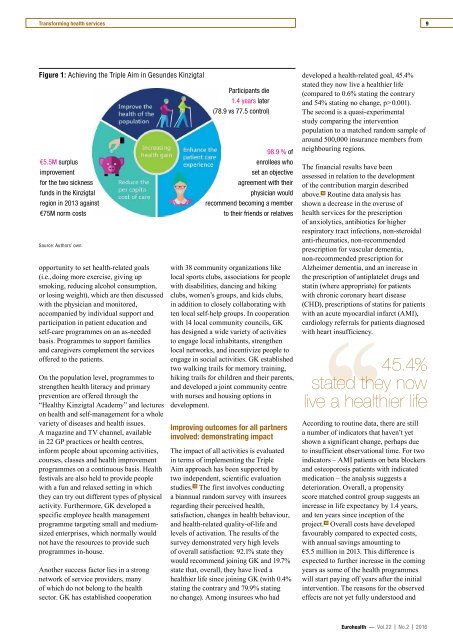EUROHEALTH
Eurohealth-volume22-number2-2016
Eurohealth-volume22-number2-2016
You also want an ePaper? Increase the reach of your titles
YUMPU automatically turns print PDFs into web optimized ePapers that Google loves.
Transforming health services<br />
9<br />
Figure 1: Achieving the Triple Aim in Gesundes Kinzigtal<br />
€5.5M surplus<br />
improvement<br />
for the two sickness<br />
funds in the Kinzigtal<br />
region in 2013 against<br />
€75M norm costs<br />
Source: Authors’ own.<br />
opportunity to set health-related goals<br />
(i.e., doing more exercise, giving up<br />
smoking, reducing alcohol consumption,<br />
or losing weight), which are then discussed<br />
with the physician and monitored,<br />
accompanied by individual support and<br />
participation in patient education and<br />
self-care programmes on an as-needed<br />
basis. Programmes to support families<br />
and caregivers complement the services<br />
offered to the patients.<br />
On the population level, programmes to<br />
strengthen health literacy and primary<br />
prevention are offered through the<br />
“Healthy Kinzigtal Academy” and lectures<br />
on health and self-management for a whole<br />
variety of diseases and health issues.<br />
A magazine and TV channel, available<br />
in 22 GP practices or health centres,<br />
inform people about upcoming activities,<br />
courses, classes and health improvement<br />
programmes on a continuous basis. Health<br />
festivals are also held to provide people<br />
with a fun and relaxed setting in which<br />
they can try out different types of physical<br />
activity. Furthermore, GK developed a<br />
specific employee health management<br />
programme targeting small and mediumsized<br />
enterprises, which normally would<br />
not have the resources to provide such<br />
programmes in-house.<br />
Another success factor lies in a strong<br />
network of service providers, many<br />
of which do not belong to the health<br />
sector. GK has established cooperation<br />
Participants die<br />
1.4 years later<br />
(78.9 vs 77.5 control)<br />
98.9 % of<br />
enrollees who<br />
set an objective<br />
agreement with their<br />
physician would<br />
recommend becoming a member<br />
to their friends or relatives<br />
with 38 community organizations like<br />
local sports clubs, associations for people<br />
with disabilities, dancing and hiking<br />
clubs, women’s groups, and kids clubs,<br />
in addition to closely collaborating with<br />
ten local self-help groups. In cooperation<br />
with 14 local community councils, GK<br />
has designed a wide variety of activities<br />
to engage local inhabitants, strengthen<br />
local networks, and incentivize people to<br />
engage in social activities. GK established<br />
two walking trails for memory training,<br />
hiking trails for children and their parents,<br />
and developed a joint community centre<br />
with nurses and housing options in<br />
development.<br />
Improving outcomes for all partners<br />
involved: demonstrating impact<br />
The impact of all activities is evaluated<br />
in terms of implementing the Triple<br />
Aim approach has been supported by<br />
two independent, scientific evaluation<br />
studies. 13 The first involves conducting<br />
a biannual random survey with insurees<br />
regarding their perceived health,<br />
satisfaction, changes in health behaviour,<br />
and health-related quality-of-life and<br />
levels of activation. The results of the<br />
survey demonstrated very high levels<br />
of overall satisfaction: 92.1% state they<br />
would recommend joining GK and 19.7%<br />
state that, overall, they have lived a<br />
healthier life since joining GK (with 0.4%<br />
stating the contrary and 79.9% stating<br />
no change). Among insurees who had<br />
developed a health-related goal, 45.4%<br />
stated they now live a healthier life<br />
(compared to 0.6% stating the contrary<br />
and 54% stating no change, p> 0.001).<br />
The second is a quasi-experimental<br />
study comparing the intervention<br />
population to a matched random sample of<br />
around 500,000 insurance members from<br />
neighbouring regions.<br />
The financial results have been<br />
assessed in relation to the development<br />
of the contribution margin described<br />
above. 14 Routine data analysis has<br />
shown a decrease in the overuse of<br />
health services for the prescription<br />
of anxiolytics, antibiotics for higher<br />
respiratory tract infections, non-steroidal<br />
anti-rheumatics, non-recommended<br />
prescription for vascular dementia,<br />
non-recommended prescription for<br />
Alzheimer dementia, and an increase in<br />
the prescription of antiplatelet drugs and<br />
statin (where appropriate) for patients<br />
with chronic coronary heart disease<br />
(CHD), prescriptions of statins for patients<br />
with an acute myocardial infarct (AMI),<br />
cardiology referrals for patients diagnosed<br />
with heart insufficiency.<br />
stated they now<br />
live a healthier life<br />
‘‘45.4%<br />
According to routine data, there are still<br />
a number of indicators that haven’t yet<br />
shown a significant change, perhaps due<br />
to insufficient observational time. For two<br />
indicators – AMI patients on beta blockers<br />
and osteoporosis patients with indicated<br />
medication – the analysis suggests a<br />
deterioration. Overall, a propensity<br />
score matched control group suggests an<br />
increase in life expectancy by 1.4 years,<br />
and ten years since inception of the<br />
project. 15 Overall costs have developed<br />
favourably compared to expected costs,<br />
with annual savings amounting to<br />
€5.5 million in 2013. This difference is<br />
expected to further increase in the coming<br />
years as some of the health programmes<br />
will start paying off years after the initial<br />
intervention. The reasons for the observed<br />
effects are not yet fully understood and<br />
Eurohealth — Vol.22 | No.2 | 2016
















